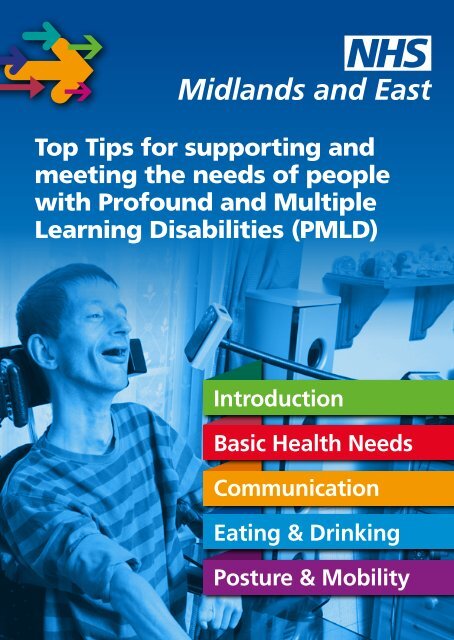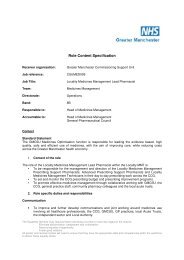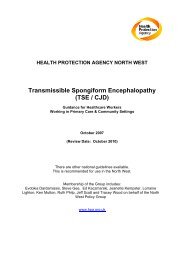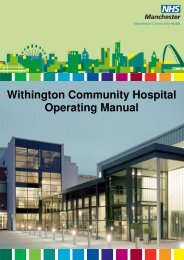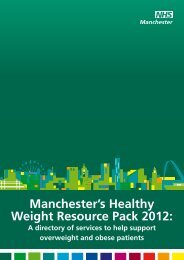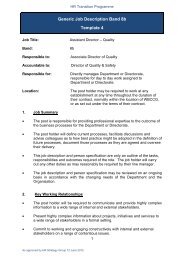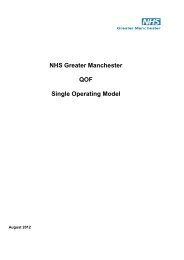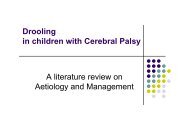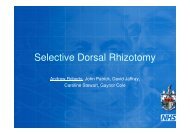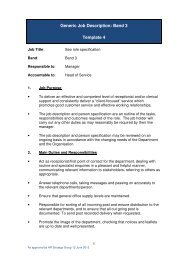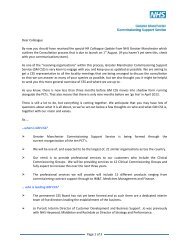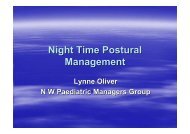Top Tips for supporting and meeting the needs of people with ...
Top Tips for supporting and meeting the needs of people with ...
Top Tips for supporting and meeting the needs of people with ...
You also want an ePaper? Increase the reach of your titles
YUMPU automatically turns print PDFs into web optimized ePapers that Google loves.
Useful resourcesHealth:• UK health <strong>and</strong> learningdisability networkwww.jan-net.co.uk• Department <strong>of</strong> Healthwww.dh.gov.uk/health/search/?searchTerms=learning+disability+publications• RCGPswww.rcgp.org.uk/clinical_<strong>and</strong>_research/circ/innovation__evaluation/learning_disabilities_resource.aspx• Learning Disabilities Observatorywww.improvinghealth<strong>and</strong>lives.org.uk/• PMLD fact sheetwww.pmldnetwork.org/pmld%20definition%20factsheet%20-%20st<strong>and</strong>ard.pdf• Mencap’s PMLDCommunications Guidewww.mencap.org.uk/page.asp?id=1539Easy read:• Easy Healthwww.easyhealth.org.uk• CHANGEwww.change<strong>people</strong>.co.ukPMLD specific:• Raising our Sightswww.dh.gov.uk/en/Publications<strong>and</strong>statistics/Publications/PublicationsPolicyAndGuidance/DH_114346• PAMISwww.pamis.org.uk/• PMLD networkwww.pmldnetwork.org/Multi media:• www.multi-me.comResearch:• Centre <strong>for</strong> disability researchwww.lancs.ac.uk/cedr/• Norah Fry research centrewww.bristol.ac.uk/norahfry/• PMLD linkwww.pmldlink.org.uk/
Introduction<strong>Top</strong> <strong>Tips</strong> <strong>for</strong> <strong>supporting</strong> <strong>and</strong> <strong>meeting</strong><strong>the</strong> <strong>needs</strong> <strong>of</strong> <strong>people</strong> <strong>with</strong> Pr<strong>of</strong>ound <strong>and</strong>Multiple Learning Disabilities (PMLD)People <strong>with</strong> Pr<strong>of</strong>ound <strong>and</strong> MultipleLearning Disabilities (PMLD)are amongst <strong>the</strong> most disabledindividuals in our community.They have a pr<strong>of</strong>ound learningdisability which means that <strong>the</strong>irintelligence quotient is estimatedto be under 20 <strong>and</strong> <strong>the</strong>re<strong>for</strong>e haveseverely limited underst<strong>and</strong>ing.In addition <strong>the</strong>y have multiple disabilities,which may include impairments <strong>of</strong> vision,hearing <strong>and</strong> movement as well as o<strong>the</strong>rproblems like epilepsy or autism.Most <strong>people</strong> in this group are unable towalk unaided <strong>and</strong> many have complexhealth <strong>needs</strong> requiring extensivehelp. People <strong>with</strong> PMLD have greaterdifficulty <strong>with</strong> communicating: <strong>the</strong>ytypically have very limited underst<strong>and</strong>ing<strong>and</strong> express <strong>the</strong>mselves through non– verbal means or at most throughusing a few words <strong>and</strong> symbols.This means that <strong>people</strong> <strong>with</strong> PMLDneed high levels <strong>of</strong> support from o<strong>the</strong>rs<strong>with</strong> most aspects <strong>of</strong> daily living: helpto eat, to wash, to dress, to use <strong>the</strong>toilet, to move about <strong>and</strong> to participatein any aspect <strong>of</strong> everyday life.All children <strong>and</strong> adults who have pr<strong>of</strong>ound<strong>and</strong> multiple learning disabilities willhave greater difficulty communicating.Many <strong>people</strong> will have additional sensoryor physical disabilities, complex health<strong>needs</strong> or mental health difficulties.People <strong>with</strong> pr<strong>of</strong>ound <strong>and</strong>multiple learning disabilities havemore than one disability.Their main disability is a pr<strong>of</strong>oundlearning disability. This means<strong>the</strong>y need lots <strong>of</strong> support.They might have <strong>the</strong>se o<strong>the</strong>rdisabilities as well.• Physical disabilities. This is adisability to do <strong>with</strong> <strong>the</strong> body• People who use a wheelchairhave a physical disability• Sensory disabilities. This is when<strong>people</strong> find it difficult to see or hear• Lots <strong>of</strong> health problems• Mental health problems• Autism• People <strong>with</strong> pr<strong>of</strong>ound <strong>and</strong> multiplelearning disabilities need a lot<strong>of</strong> support: They also find it verydifficult to communicate
IntroductionDespite such serious impairments, <strong>people</strong><strong>with</strong> PMLD can <strong>for</strong>m relationships,make choices <strong>and</strong> enjoy activities. The<strong>people</strong> who love <strong>and</strong> care <strong>for</strong> <strong>the</strong>mcan <strong>of</strong>ten underst<strong>and</strong> <strong>the</strong>ir personality,<strong>the</strong>ir mood <strong>and</strong> <strong>the</strong>ir preferences.These <strong>Top</strong> Ten <strong>Tips</strong> have been developedto support everyone, pr<strong>of</strong>essionals <strong>and</strong>carers alike to help <strong>the</strong> person <strong>with</strong> PMLDlive a fullfilling, happy <strong>and</strong> healthy life.It is important that everyone underst<strong>and</strong>sthat <strong>people</strong> <strong>with</strong> pr<strong>of</strong>ound <strong>and</strong> multiplelearning disabilities have <strong>the</strong> same rightsas every o<strong>the</strong>r citizen. We must enableeach individual to engage <strong>with</strong> <strong>the</strong>irworld <strong>and</strong> achieve <strong>the</strong>ir potential sothat <strong>the</strong>ir lives go beyond being `cared<strong>for</strong>` to be valued <strong>for</strong> who <strong>the</strong>y are as<strong>people</strong>. www.pmldnetwork.org/In <strong>the</strong> words <strong>of</strong> a family carer:“People <strong>with</strong> PMLD are just that:PEOPLE <strong>and</strong> <strong>supporting</strong> <strong>the</strong>m to livea fulfilling, happy <strong>and</strong> healthy lifeis everybodys responsibility.”It is acknowledged that <strong>the</strong>re are anumber <strong>of</strong> definitions used world wide,<strong>for</strong> example Pr<strong>of</strong>ound Intellectual <strong>and</strong>Multiple Disabilities (PIMD) (Reference:`Raising our Sights: Services <strong>for</strong> Adults<strong>with</strong> Pr<strong>of</strong>ound Intellectual <strong>and</strong> MultipleDisabilities’, Pr<strong>of</strong>essor Jim Mansell 2010).PMLD Network (2002) `ValuingPeople <strong>with</strong> Pr<strong>of</strong>ound <strong>and</strong> MultipleLearning Disabilities (PMLD)`www.pmldnetwork.orgDepartment <strong>of</strong> Health (2001) ‘Valuing<strong>people</strong>: a New Strategy <strong>for</strong> LearningDisability <strong>for</strong> <strong>the</strong> 21st Century’.Fur<strong>the</strong>r readingBellamy, G Croot L, Bush, A, Berry H. SmithA (2010) A study to define pr<strong>of</strong>ound<strong>and</strong> multiple learning disabiliites (PMLD)Journal <strong>of</strong> intellectual disabilities,September 2010, Vol. 14, 3:pp.221-235
Basic Health Needs10 <strong>Top</strong> <strong>Tips</strong> <strong>for</strong> <strong>supporting</strong> <strong>the</strong> basic health <strong>needs</strong><strong>of</strong> <strong>people</strong> <strong>with</strong> PMLD1People <strong>with</strong> Pr<strong>of</strong>ound <strong>and</strong> Multiple Learning Disabilities have greaterhealth <strong>needs</strong> than <strong>the</strong> general population. They are more likely to have<strong>the</strong> following conditions;Respiratory Disease, Epilepsy, Coronary heart disease, Gastrointestinal reflux,Diabetes, Helicobacter pylori, Osteoporosis.http://www.advocacyresource.org.uk/LD (Raising Our Sights report)2It is important to recognise when someone <strong>with</strong> PMLD is in pain <strong>and</strong> tomanage this effectivelyListen to those who know <strong>the</strong> person well, ask about any changes in behaviour<strong>and</strong> interactions, facial expressions <strong>and</strong> gestures, reduction in appetite.3There should be an annual health check <strong>and</strong> assessmentThe GP <strong>and</strong>/or community nurse will arrange this, always involve <strong>the</strong> carers.www.rcgp.org.uk/pdf/CIRC_A%20Step%20by%20Step%20Guide%20<strong>for</strong>%20Practices%20(October%2010).pdf - When page open use search tool, entering‘Annual health checks <strong>for</strong> <strong>people</strong> <strong>with</strong> learning disabilities’ to find step by stepguide.4Involve pr<strong>of</strong>essionals who can <strong>of</strong>fer support <strong>and</strong> advice in <strong>the</strong> community<strong>and</strong> hospitalCommunity learning disability nurse, health liaison/facilitator, acute liaison/facilitator, dietitian, physio<strong>the</strong>rapist, speech <strong>and</strong> language <strong>the</strong>rapist.5Don’t make assumptions about <strong>the</strong> person’s symptoms, quality <strong>of</strong> lifeListen to those who know <strong>the</strong> person well, read <strong>the</strong>ir Health Action Plan (HAP)/Person Centred Plan (PCP).
Basic Health Needs6Adjustments should be made to ensure that <strong>people</strong> <strong>with</strong> PMLDcan access servicese.g. longer appointment times, ensure equipment such as hoists are availableOrganisations have to make sure that <strong>the</strong>re is equal access to services.Visit: www.equalityhumanrights.comhttp://www.improvinghealth<strong>and</strong>lives.org.uk/publicationsClick on <strong>the</strong> ‘Reasonable Adjustments’ link7Use resources to help <strong>people</strong> <strong>with</strong> PMLD have a positive experience inhospital settingsCommunication tool/passport, traffic light assessment, health action plan.An example can be found on: www.easyhealth.org.uk8Be aware <strong>of</strong> good dental <strong>and</strong> oral hygiene, weight changes, appetite,<strong>and</strong> skin integritywww.dentalhealth.org.uk9Be aware <strong>of</strong> <strong>the</strong> importance <strong>of</strong> eye care <strong>and</strong> visionVisit your local opticianor visit www.lookupinfo.org10It is essential to know <strong>and</strong> follow <strong>the</strong> principles <strong>of</strong> <strong>the</strong> Mental Capacity ActThe law says that <strong>people</strong> must be supported as much as possible to make <strong>the</strong>irown decision be<strong>for</strong>e anyone concludes <strong>the</strong>y lack capacity to make that decision.Best interests should be followed when a person lacks capacity.
Communication10 <strong>Top</strong> <strong>Tips</strong> <strong>for</strong> <strong>supporting</strong> <strong>the</strong> communication<strong>needs</strong> <strong>of</strong> <strong>people</strong> <strong>with</strong> PMLD1Gain in<strong>for</strong>mation about communication from a parent, key worker orpaid carer <strong>with</strong> a long relationship <strong>with</strong> <strong>the</strong> personMencap’s PMLD communication guide has useful hints <strong>and</strong> tipswww.mencap.org.uk/page.asp?id=15392Key In<strong>for</strong>mation about <strong>the</strong> individual’s communication <strong>needs</strong> should befound in: communication tool/passport, traffic light assessment or healthaction planwww.totalcommunication.org.uk or www.scope.org.uk orlocal speech <strong>and</strong> language <strong>the</strong>rapist (SALT) www.rcslt.org3Hearing <strong>and</strong> or vision can impact upon communicationVisit www.lookupinfo.org to find a local optician who makes adaptationsto <strong>the</strong>ir eye tests <strong>for</strong> <strong>people</strong> <strong>with</strong> learning disabilities. A hearing test can bearranged through <strong>the</strong> individual’s GP.4Objects or photographs can help <strong>the</strong> person to underst<strong>and</strong> whatis happeningFor more in<strong>for</strong>mation on objects <strong>of</strong> reference visitwww.totalcommunication.org.uk or contact your local SALT.5Allow more time <strong>for</strong> <strong>the</strong> person to process what is being said <strong>and</strong>what is happeningAllow plenty <strong>of</strong> time <strong>for</strong> conversations <strong>and</strong> reduce distractions.
Communication6A person may be trying to tell you something through<strong>the</strong>ir facial expression <strong>and</strong> body languageTalk to someone who knows <strong>the</strong> person well or refer to in<strong>for</strong>mation on/in<strong>the</strong> individual’s communication tool to ensure you interpret <strong>the</strong>ir non-verbalcommunication accurately.7The person may have a communication aidCan <strong>the</strong> person use a BIGmack switch or ano<strong>the</strong>r electronic device tomake requests? Visit www.ace-centre.org.uk <strong>for</strong> more in<strong>for</strong>mation orcontact local SALT.8Make sure that you help <strong>the</strong> person have a chat/tell <strong>the</strong>ir storyIntensive interaction www.intensiveinteraction.co.uk <strong>and</strong> interactive storytelling www.bagbooks.org <strong>of</strong>fer ideas on how to approach interaction.9Make sure <strong>the</strong> environment encourages communication <strong>and</strong> interactionExploring different sensory experiences toge<strong>the</strong>r promotes sharedcommunication e.g. objects to touch, sounds, things to look at or watch,opportunities <strong>for</strong> movement, things to taste <strong>and</strong> or smell.10Follow <strong>the</strong> principles <strong>of</strong> <strong>the</strong> Mental Capacity Act to support someoneto make a decision or if <strong>the</strong>y lack capacity, act in <strong>the</strong>ir best interestsIt may be beneficial <strong>for</strong> <strong>the</strong> person to have an advocate who can make sure thateveryone who knows <strong>the</strong> person well is involved, communication tools, HAP’s<strong>and</strong> person centred plans are followed.
Eating & Drinking10 <strong>Top</strong> <strong>Tips</strong> <strong>for</strong> <strong>supporting</strong> <strong>the</strong> eating <strong>and</strong> drinking<strong>needs</strong> <strong>of</strong> <strong>people</strong> <strong>with</strong> PMLD1Supporting eating & drinking <strong>needs</strong> falls <strong>with</strong>in <strong>the</strong> expertise <strong>of</strong> a range<strong>of</strong> different pr<strong>of</strong>essionals <strong>and</strong> agenciesVisit: www.rcplondon.ac.uk www.npsa.nhs.ukwww.cwt.org.uk/publications.html?ewld2Good nutrition is vital <strong>for</strong> good healthLook out <strong>for</strong>:• Visible weight loss• Changes in appetite• Changes in behaviour at mealtimesDietitians provide support <strong>for</strong> both oral <strong>and</strong> non-oral feeding regimes.www.bda.uk.comThe MUST is a useful screening tool <strong>for</strong> malnutrition. www.bapen.org.uk3Adequate hydration is vitalFluid can be given in a range <strong>of</strong> <strong>for</strong>ms such as puddings, jellies, soups <strong>and</strong>smoothies.4Chewing <strong>and</strong> swallowing can be problematic <strong>and</strong> coughing/choking at drink/mealtimes can lead to chest infectionsContact Speech <strong>and</strong> Language Therapy service so that a Dysphagia assessmentcan be carried out. Advice will be given re. best techniques <strong>and</strong> safest food/drink textures.To find a speech <strong>and</strong> language <strong>the</strong>rapist visit: www.rcslt.org.uk5A good posture must be achieved during mealtimesContact local Physio<strong>the</strong>rapy service <strong>for</strong> advice.To find a Physio visit: www.csp.org.uk
Eating & Drinking6Adaptive crockery or cutlery or o<strong>the</strong>r mealtime aids can be beneficialContact local Occupational Therapy service <strong>for</strong> advice.To find an OT visit: www.cot.co.uk7Good oral hygiene can help prevent chest infectionsA Specialist Dentist or Oral Health Advisor can help. Contact local communitydental service or visit: www.dentalhealth.org.uk8Medication may be given in tablet/syrup/jelly or suspension <strong>for</strong>m toassist swallowingContact local GP or local Pharmacist <strong>for</strong> advice.9Communicate in<strong>for</strong>mationEnsure ALL available advice is readily accessible to everyone involved inmealtimes <strong>and</strong> that a copy <strong>of</strong> guidelines is in <strong>the</strong> Health Action Plan.10When giving food/drink to someone:• Give choices wherever possible• Use <strong>the</strong> right utensils• Check <strong>the</strong> textures are correct• Consider <strong>the</strong> best environment <strong>for</strong> <strong>the</strong> person• Adjust your rhythm <strong>and</strong> pacing to suit <strong>the</strong> individualNB Find out what it feels like to be assisted by ano<strong>the</strong>r person wheneating/drinking!
Posture & Mobility10 <strong>Top</strong> <strong>Tips</strong> <strong>for</strong> <strong>supporting</strong> <strong>the</strong> postural <strong>and</strong>mobility <strong>needs</strong> <strong>of</strong> <strong>people</strong> <strong>with</strong> PMLD1A 24-hour approach to postural-careIt is vital to consistently support posture throughout <strong>the</strong> day <strong>and</strong> night inorder to reduce <strong>the</strong> risk <strong>of</strong> complications associated <strong>with</strong> severe physicaldisability e.g. pain, pressure sores, spinal de<strong>for</strong>mity, joint contractures <strong>and</strong>respiratory infection.www.posturalcareskills.com2Details <strong>of</strong> local specialist postural-care <strong>the</strong>rapists <strong>and</strong> o<strong>the</strong>rpr<strong>of</strong>essionals involved in care should be identified in <strong>the</strong> person’sHealth Action Plan (HAP)This will include:Physio<strong>the</strong>rapist/OTWheelchair <strong>the</strong>rapist/servicesDistrict nurse3Postural-care guidelines <strong>and</strong> equipment should be agreed be<strong>for</strong>e <strong>the</strong>yare issuedClient <strong>and</strong> carers should be involved <strong>with</strong> assessment, selection <strong>and</strong> issue <strong>of</strong>equipment <strong>and</strong> review to ensure equipment <strong>and</strong> guidelines are acceptable <strong>and</strong>‘fit’ <strong>with</strong> family life.4Clear photographic postural-care guidelines should be issued along <strong>with</strong>training <strong>and</strong> supportAsk <strong>the</strong> specialist <strong>the</strong>rapist about this.5Contact a specialist <strong>the</strong>rapist to support training in 24-hour postural-care
Posture & Mobility6Make sure that postural-care guidelines <strong>and</strong> equipment are reviewed aspart <strong>of</strong> an annual review <strong>of</strong> health <strong>needs</strong>In order to reduce risk <strong>of</strong> complications, annual reviews should be arranged<strong>with</strong> your specialist <strong>the</strong>rapist to establish whe<strong>the</strong>r equipment <strong>and</strong> guidelinesremain appropriate.7Be aware <strong>of</strong> any gain or loss <strong>of</strong> weight or a change in body shape“Made to measure” supportive equipment may no longer be appropriate <strong>and</strong>could increase <strong>the</strong> risk <strong>of</strong> complications (see 1.)Arrange a review <strong>with</strong> a specialist <strong>the</strong>rapist.8Be aware <strong>of</strong> skin integrity, don’t ignore areas <strong>of</strong> reddened, blistered orbroken skin. If you have concerns:• Contact a district nurse immediately <strong>for</strong> assessment, treatment <strong>and</strong> advice• Contact a specialist physio<strong>the</strong>rapist or occupational <strong>the</strong>rapist as an urgentreview <strong>of</strong> postural-care <strong>and</strong> seating / lying equipment may be indicated.9The prescribed equipment should improve quality <strong>of</strong> lifeEquipment should be com<strong>for</strong>table, enable purposeful activity <strong>and</strong> should notcause harm. Contact a specialist if concerned.10Hospital staff need to be aware <strong>of</strong> postural-care guidelines <strong>for</strong> anyadmission, this includes bathing <strong>and</strong> toileting <strong>needs</strong>
My Notes & Contacts:
Copyright © 2012


